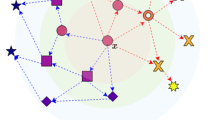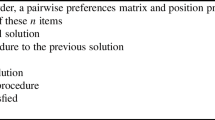Abstract
In this paper, we advocate a learning task that deals with the orders of objects, which we call the Supervised Ordering task. The term order means a sequence of objects sorted according to a specific property, such as preference, size, cost. The aim of this task is to acquire the rule that is used for estimating an appropriate order of a given unordered object set. The rule is acquired from sample orders consisting of objects represented by attribute vectors. Developing solution methods for accomplishing this task would be useful, for example, in carrying out a questionnaire survey to predict one’s preferences. We develop a solution method based on a regression technique imposing a Thurstone’s model and evaluate the performance and characteristics of these methods based on the experimental results of tests using both artificial data and real data.
Similar content being viewed by others
References
Agresti A (1996) Categorical data analysis. Wiley
Anderson JA and Philips PR (1981). Regression, discrimination and measurement models for ordered categorical variables. J R Stat Soc (C) 30(1): 22–31
Arnold BC, Balakrishnan N, Nagaraja HN (1992) A first course in order statistics. Wiley
Arrow KJ (1963) Social choice and individual values, 2nd edn. Yale University Press
Babington Smith B (1950) Discussion on professor ross’s paper. J R Stat Soc (B) 12:53–56, (A. S. C. Ross, Philological Probability Problems, pp 19–41)
Cohen WW, Schapire RE and Singer Y (1999). Learning to order things. J Artif Intel Res 10: 243–270
de Condorcet M (1995) On constitution and the functions of provincial assemblies (1788). In: McLean I, Urken AB (eds) Classics of social choice, The University of Michigan Press, chap 7, pp 113–144
Fligner MA and Verducci JS (1990). Posterior probabilities for a consensus ordering. Psychometrika 55(1): 53–63
Hayashi C (1952). On the prediction of phenomena from qualitative data and the quantification of qualitative data from the mathematico-statistical point of view. Ann Inst Stat Math 3: 69–98
Herbrich R, Graepel T, Bollmann-Sdorra P, Obermayer K (1998) Learning preference relations for information retrieval. In: ICML-98 Workshop: text categorization and machine learning, pp 80–84
Joachims T (2002) Optimizing search engines using clickthrough data. In: Proceedings of the 8th international conference on knowledge discovery and data mining, pp 133–142
Kamishima T (2003) Nantonac collaborative filtering: Recommendation based on order responses. In: Proceedings of the 9th International conference on knowledge discovery and data mining, pp 583–588
Kamishima T, Akaho S (2004) Filling-in missing objects in orders. In: Proceedings of the IEEE International conference on data mining
Kamishima T, Fujiki J (2003) Clustering orders. In: Proceedings of the 6th International conference on discovery science, pp 194–207, [LNAI 2843]
Kendall M, Gibbons JD (1990) Rank correlation methods, 5th edn. Oxford University Press
Lebanon G, Lafferty J (2002) Crankng: combining rankings using conditional probability models on permutations. In: Proceedings of the 19th International conference on machine learning, pp 363–370
Mallows CL (1957). Non-null ranking models. I Biometrika 44: 114–130
Mannila H, Meek C (2000) Global partial orders from sequential data. In: Proceedings of the 6th International conference on knowledge discovery and data mining, pp 161–168
Marden JI (1995) Analyzing and modeling rank data, monographs on statistics and applied probability, vol 64. Chapman & Hall
McCullagh P (1980). Regression models for ordinal data. J R Stat Soc (B) 42(2): 109–142
Mitchell TM (1997) Machine learning. The McGraw-Hill
Mosteller F (1951). Remarks on the method of paired comparisons: I—the least squares solution assuming equal standard deviations and equal correlations. Psychometrika 16(1): 3–9
Nakamori Y (2000) Kansei data Kaiseki. Morikita Shuppan Co., Ltd., (in Japanese)
Osgood CE, Suci GJ, Tannenbaum PH (1957) The Measurement of meaning. University of Illinois Press
Plackett RL (1975). The analysis of permutations. J R Stat Soc (C) 24(2): 193–202
Sai Y, Yao YY, Zhong N (2001) Data analysis and mining in ordered information tables. In: Proceedings of the IEEE International conference on data mining, pp 497–504
Thurstone LL (1927). A law of comparative judgment. Psychol Rev 34: 273–286
Author information
Authors and Affiliations
Corresponding author
Rights and permissions
About this article
Cite this article
Kamishima, T., Akaho, S. Supervised ordering by regression combined with Thurstone’s model. Artif Intell Rev 25, 231–246 (2006). https://doi.org/10.1007/s10462-007-9050-5
Published:
Issue Date:
DOI: https://doi.org/10.1007/s10462-007-9050-5




